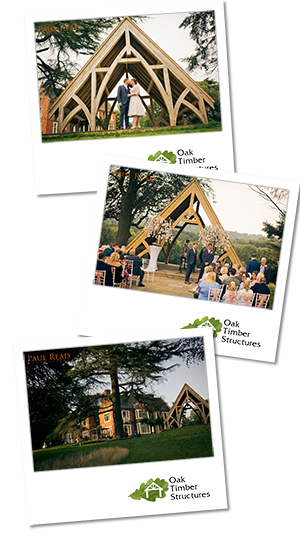
Contact us 01889 597 283 | contact@oaktimberstructures.co.uk
Contact us 01889 597 283 | contact@oaktimberstructures.co.uk
Expertly crafted, bespoke oak venue gazebo delivered as a kit, ready to assemble.
On hand held devices we recommend flipping the screen horizontally whilst designing your structure.
Movement Scale
Move Structure into Position
Enlarge / Shrink Structure
Rotate Along Y Axis
Rotate Along X Axis
Rotate Along Z Axis
Remove Background Image and Reset
At Oak Timber Structures, we create bespoke solid oak venue gazebos catered to your every need. Design yours, place the order, and we’ll send a CAD drawing ready for approval. Once approved, our skilled in-house artisans get to work. They’ll bring your vision to life and carve your gazebo from high-quality European Oak. We’ll then deliver the kit form venue gazebo for you or your builder to assemble on-site.
As a venue owner, you'll understand it's important to stand out from the crowd. You'll also know that some venues have that wow factor that attracts clients. What makes venues catch the eye? There's no denying there are several contributing factors, but none more critical than the architecture.
Our bespoke oak venue gazebos add brilliance to your business. Their purposes stretch far and wide. Maybe you're a wedding venue looking to add an outdoor site for the exchanging of vows. Perhaps you’re a restaurant owner wanting to level up your business with luxurious outside dining. Or even a stately home wanting a covered spot for guests to relax. Whatever your plan, oak venue gazebos hold the key to making your business shine.
Oak venue gazebos offer an eye-catching aesthetic that will become a hallmark of your business. With a gable roof that extends towards the floor and decorative arched braces, it’s both a distinct and exquisite design feat. Not only wowing guests with its elegant design, but it also provides a practical way to keep visitors covered from the rain or blazing sun.

Every oak venue gazebo is bespoke, meaning they're handmade to order. Because they're made from scratch, we can cater the oak venue gazebo to your every need. Change the width, depth and height to achieve the perfect fit for your venue.
Our skilled artisans have 100-plus years of experience in woodwork. So when they get their hands on the high-grade European Oak, you can expect only the best in craftsmanship. Each post and beam is subject to meticulous attention to detail. Our team plane each piece of oak before sanding it for a smooth finish. They’ll complete the carpentry work using time-honoured procedures, leaving you with a classic structure that will amaze you and your guests.
To make sure that the oak venue gazebo is inch-perfect, we’ll perform a test assembly prior to packaging. After the once-over, we’ll then disassemble the venue gazebo and pack it into a kit. Hey presto, it’s ready for delivery.
So are you ready to make an investment that'll leave your guests happy? If you think your venue could enjoy the regal majesty of an oak venue gazebo, then start designing yours on the 3D Oak Venue Gazebo Designer. Got something distinct in mind? No worries. Send a simple sketch to contact@oaktimberstructures.co.uk or call us on 01889 597 283 to discuss.


We've put together a booklet of detailed answers to our most commonly asked questions. A perfect in-depth read about buying your oak structure from us.
This booklet is updated regularly to answer any new questions we've recieved.
BRITMET LiteSlate is a new roofing option we are supplying as an alternative to Cedar Shingles.
We offer a range of colours including:
LiteSlate is easy to install, lightweight and is virtually maintenance free!
Please take a look at the below BRITMET documentation for more information including comprehensive installation guidelines.
Browse photographs kindly sent in from previous clients: